
A Lively Labyrinth
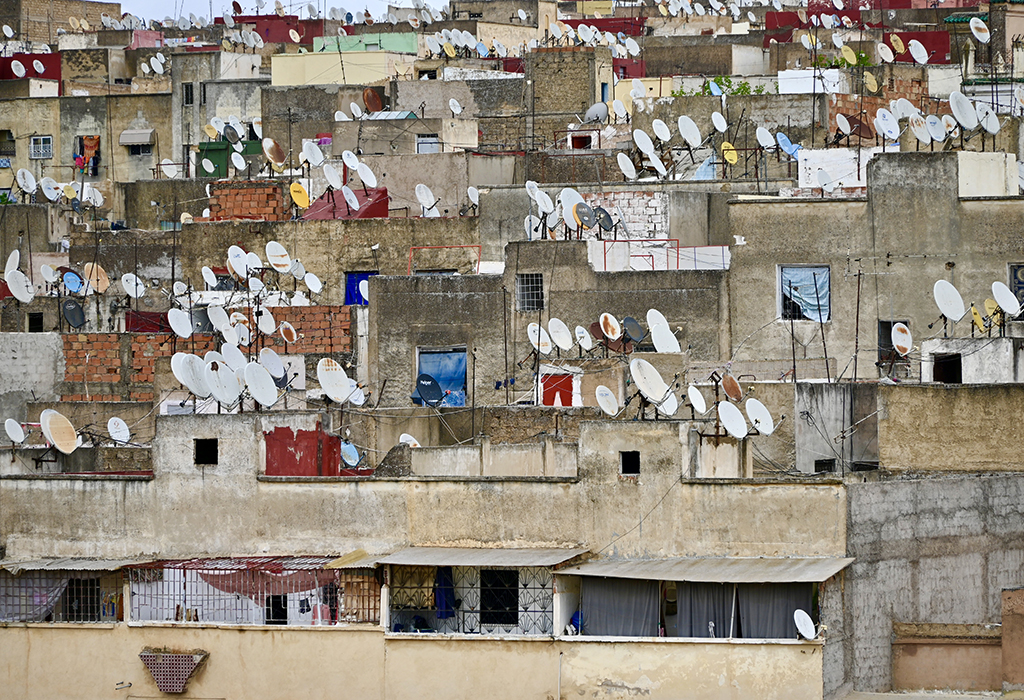
This is part three of my five-part series on Morocco. I have provided links (in purple) whenever possible; several places do not have websites, but they often have Wikipedia pages. Please be sure to read the notes at the end of this post as you consider traveling to this beautiful country.
The Medina of Fès (the spelling “fez” is reserved for the hat) covers a square mile, though nothing is actually square in Fès. A UNESCO World Heritage Site, the Medina comprises several medinas (Arab, Jewish, Andalusian, and Berber) that include 9,500 streets that house upwards of 100,000 people in addition to being home to myriad mosques, madrasas, restaurants, hotels, and souks. (As a reference point, the Medina’s population was only 40,000 when I was there in 1991.) For the most part, it is a place I would never go without a guide —but not for fear of my safety, but simply for finding its many treasures. As in Venice, one easily gets lost in Fès’ labyrinthine streets, alleys, and lanes. Some are so narrow that pedestrians must turn sideways; open umbrellas are impossible.
Riad Myra
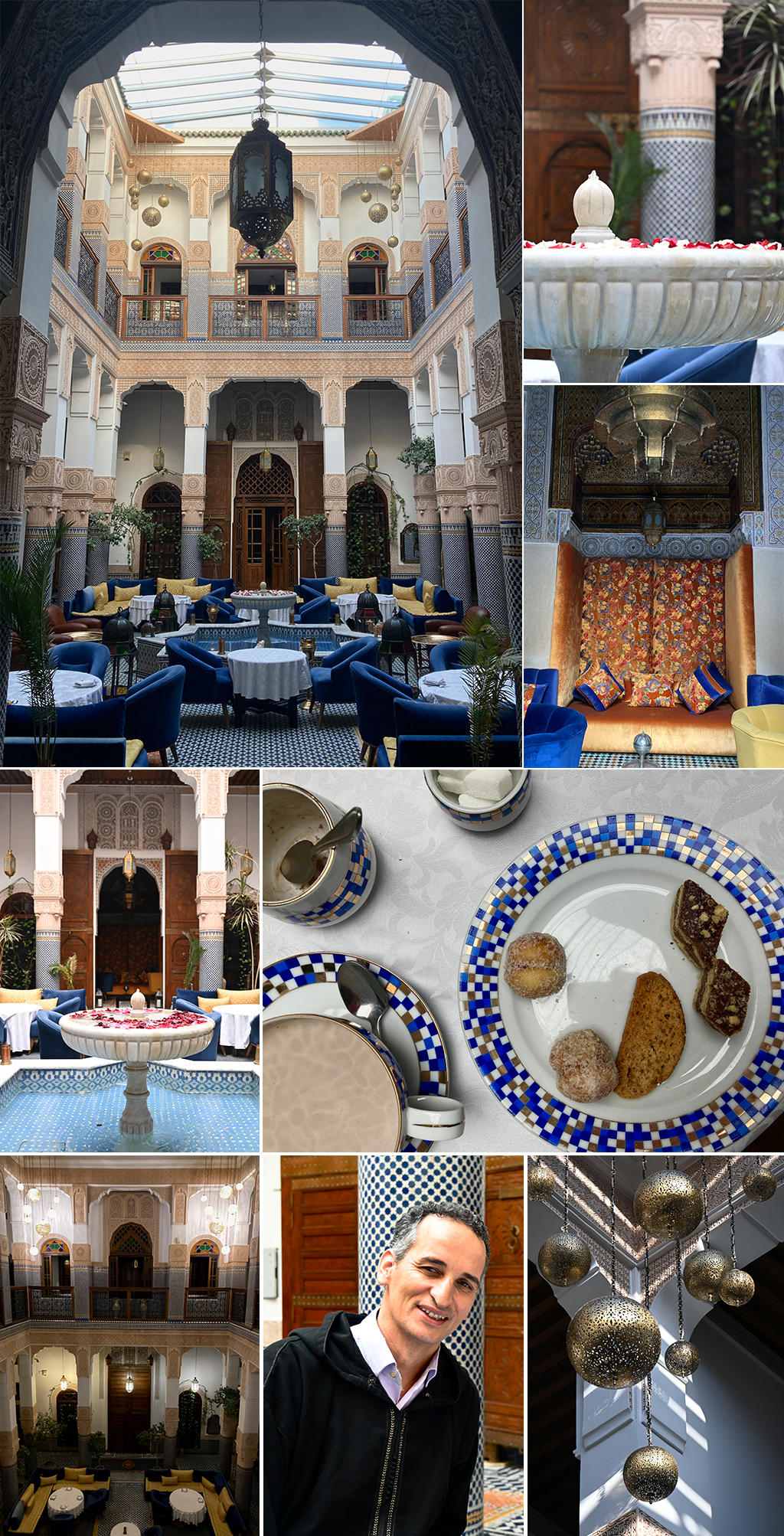
Our anticipated 6:30pm arrival followed by a 7:00pm dinner was not to be. Due to some delays on the road, we arrived at the Riad Myra at 10:45pm… depleted of all our energy. The generous and thoughtful hotel staff had stayed on duty for more that two hours past their closing time to welcome us and feed us before we finally made it to our rooms for sleep.
The riad is exquisite. It has been a dream of mine to stay in such a place and, as exhausted as I was upon entering, my spirit leapt when I saw the courtyard, adorned with zellij and carved plaster. It was softly lit at night, and our table for six awaited us in the corner. Every time I entered over the next few days, I took more and more photographs. The courtyard, with its trickling central fountain, was a lovely place to enjoy a mid-afternoon cup of mint tea (or chocolate) and some biscuits. One thing to know about staying in an authentic mid-Medina riad: you generally do not have windows to the outside world. Any windows face into the courtyard. One of our party felt this made the rooms dark; though she meant it as a negative, I simply responded: “Yes! Perfect for sleeping.” Which, honestly, is the only thing you should do in your room in a city as enchanting as Fès.
A true highlight of this stay was Monsieur Ibrahim, who greeted us at the city gate when we arrived and waved us off a few days later as we motored on to Chefchaouen. He once mentioned he was the night-duty staff, but I was never in the riad when he was not there being the most gracious imaginable host.
The Palace Gates

Apparently, it is standard guide protocol to start a tour of Fès by taking the group to see the gates of the king’s palace. We did it in 1991; we did it in 2023. As a current royal residence, the palace is not open to the public, so you simply marvel at its seven gates and their zellij tile work, brass doors, carved plaster, and marble columns. I loved it both then and now. We were told that the number seven is an auspicious number in Morocco: seven saints, seven days of the week, seven vegetables with couscous, seven-day wedding celebrations… and seven gates to the king’s palace. Just in case, I’ll keep seven as one of my lucky numbers.
The Medina(s), The Souks
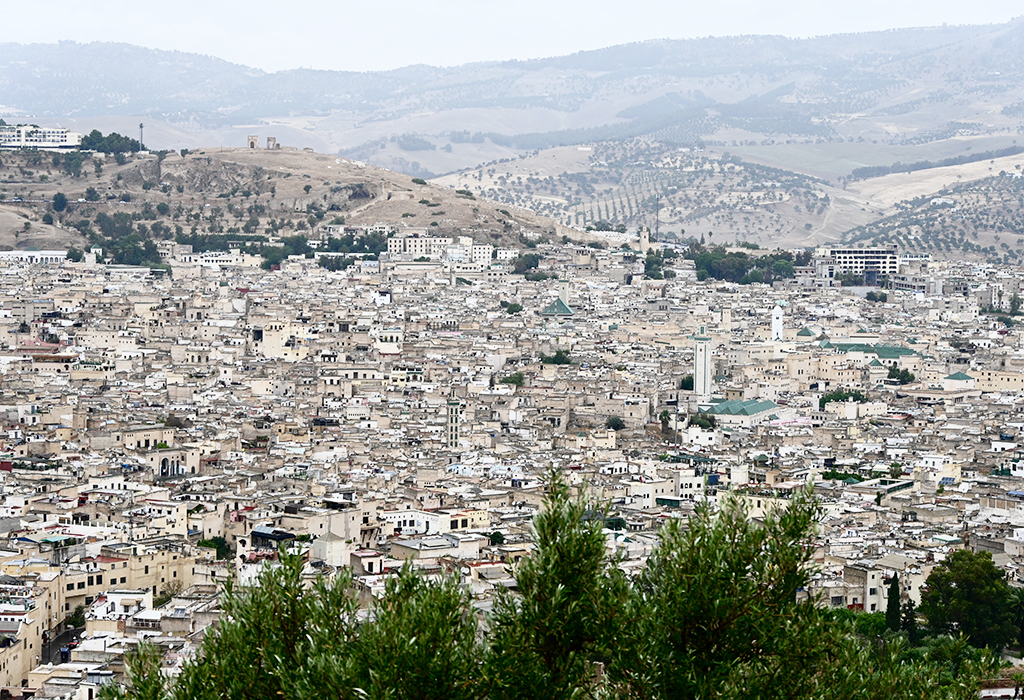
We drove up to a hillside (in both 1991 and 2023), for a panoramic view of the city. This helps understand the immensity and intricacy of the Medina. Looking down in all directions you can see the different clusters of buildings that define the four historic walled medinas.
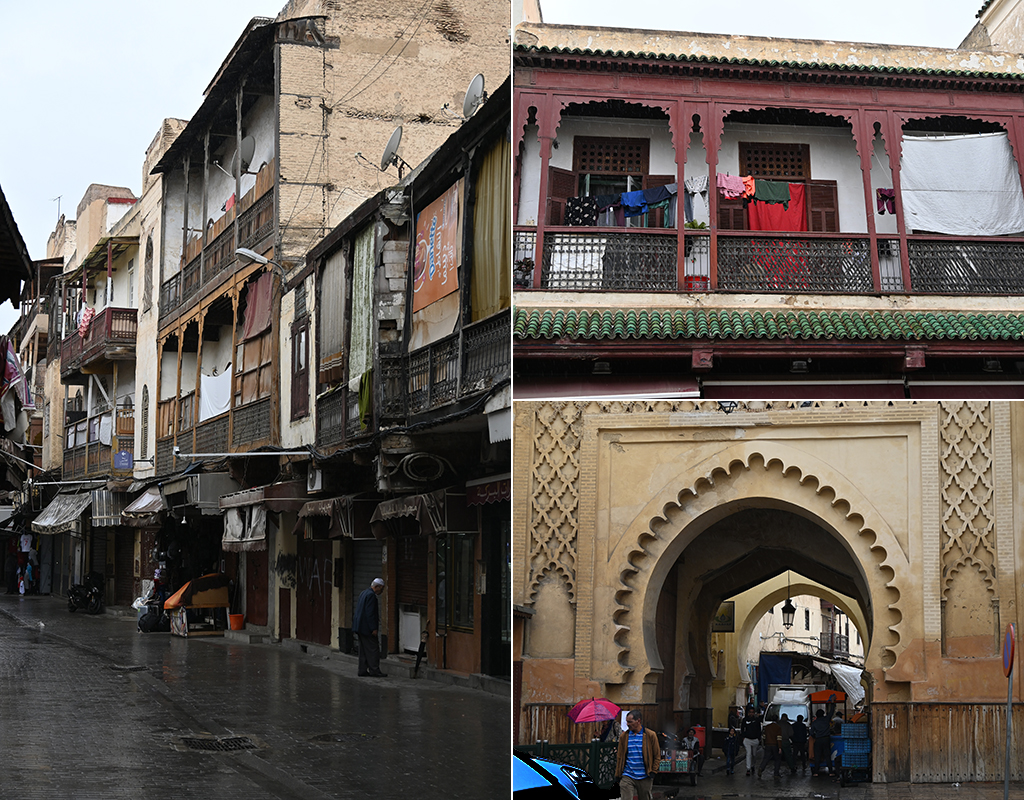
Our guide, Said (sī-EED), started our tour by walking us through part of the Jewish Medina (or mellah) to point out the differences in domestic architecture in that Medina that we would not see in others. The most distinguishing feature were the windows and balconies overlooking the street, whereas in the other medinas, homes were built around inward-facing courtyards. A house with a small courtyard is called a dar; one with a courtyard big enough for a few trees or a garden is called a riad. The difference remains blurry to us. Our time was short relative to the size of the city and its treasures, so we got only a glimpse through the Bab Semmarine, the original southern gate, into one of the several walled sections of the medina.

Under the tutelage of our guide, we walked many convoluted lanes, weaving in all directions. There is a mystery in these narrow passages that invited me to go further into the unknown to see what was beyond. Some have little to no color, while others are vibrantly decorated, and some with just a nod to decoration. It was while Mark and I were exploring on our own (leaving a trail of breadcrumbs, to be sure) that we can upon three international architecture students in an opening off a minuscule alley, who interviewed us on possible future use of the space. It will become a public space of their design, and the funds are set aside for its implementation. But the students were gathering every idea and angle they could, from local residents and random passersby such as us.
Then, as we ventured into the souks, we passed cookware…. and a taco shop!

… beautiful vegetables, olives, pastries, and breads….

… men dyeing fabric in vats of indigo blue, yarns dyed and drying over the street, and silk threads dyed to match the beautiful fabrics we saw on all the women…

We stopped into Les Merveilles du Tapis — a carpet store, where our friends bought a carpet and we got to sit on the sidelines, sipping piping hot mint tea while we watched the kaleidoscopic show of one rug being thrown open after another.
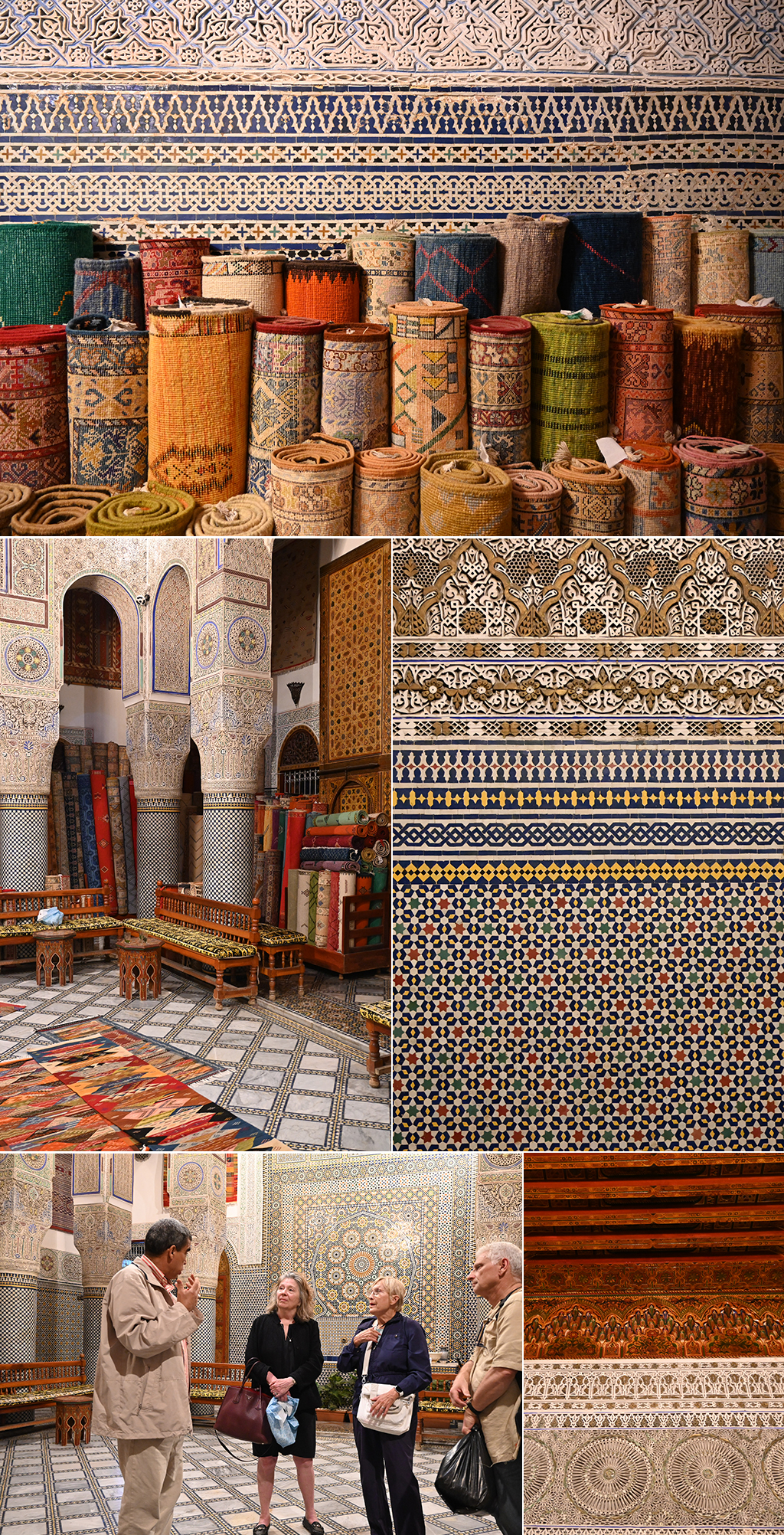 We also made the requisite stop at the Chouara Tannery. We were each given a sprig of mint to hold to our noses (to mask the stench of rotting leather), and we climbed up wonky stairs to balconies whence we could view the tanning and dying vats and the workmen carrying and hanging hides. As the day was cold, windy, and rainy, we didn’t need our mint all that much (I did in 1991!). After the viewing, there is a reasonably hard sell to purchase something. Happily, some of our crew were indeed looking for some leather goods, so there was no pressure on us.
We also made the requisite stop at the Chouara Tannery. We were each given a sprig of mint to hold to our noses (to mask the stench of rotting leather), and we climbed up wonky stairs to balconies whence we could view the tanning and dying vats and the workmen carrying and hanging hides. As the day was cold, windy, and rainy, we didn’t need our mint all that much (I did in 1991!). After the viewing, there is a reasonably hard sell to purchase something. Happily, some of our crew were indeed looking for some leather goods, so there was no pressure on us.
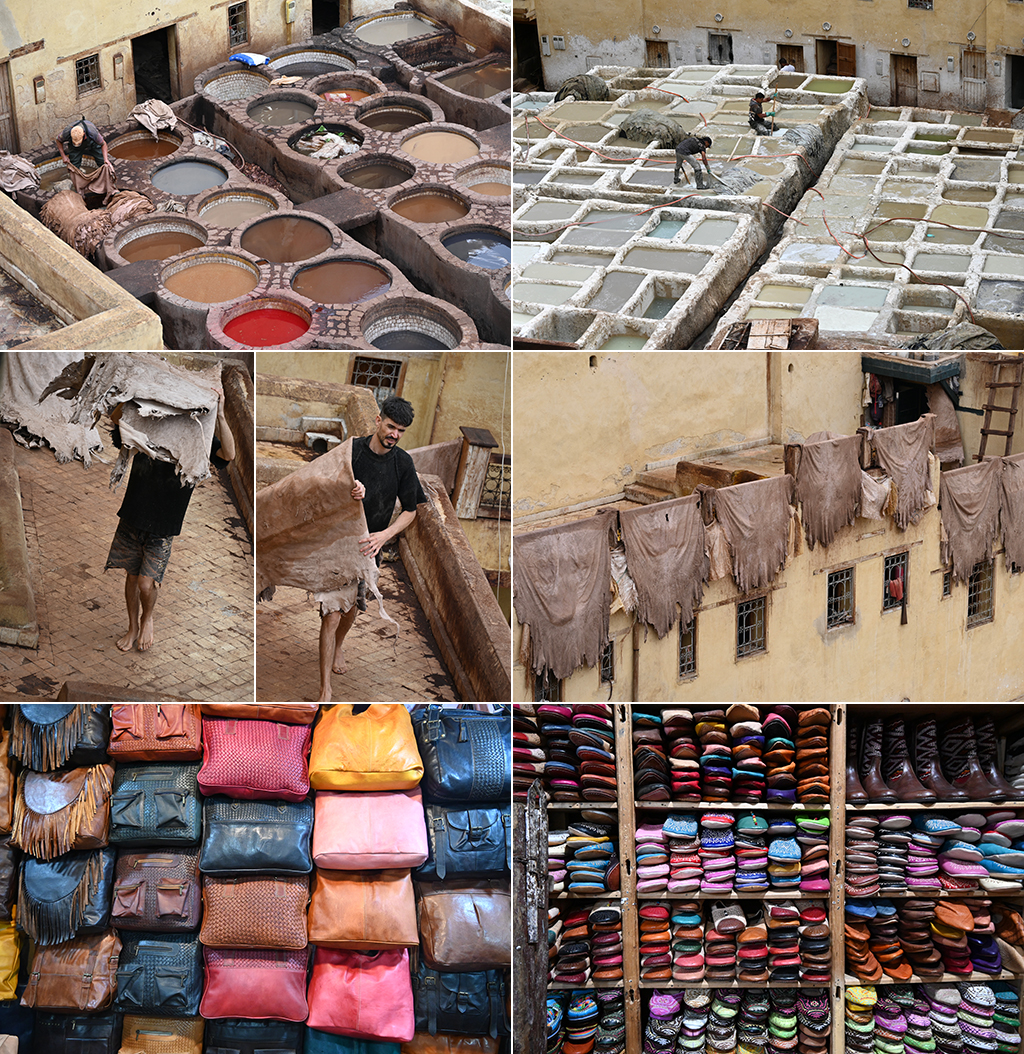
Atelier Art Naji
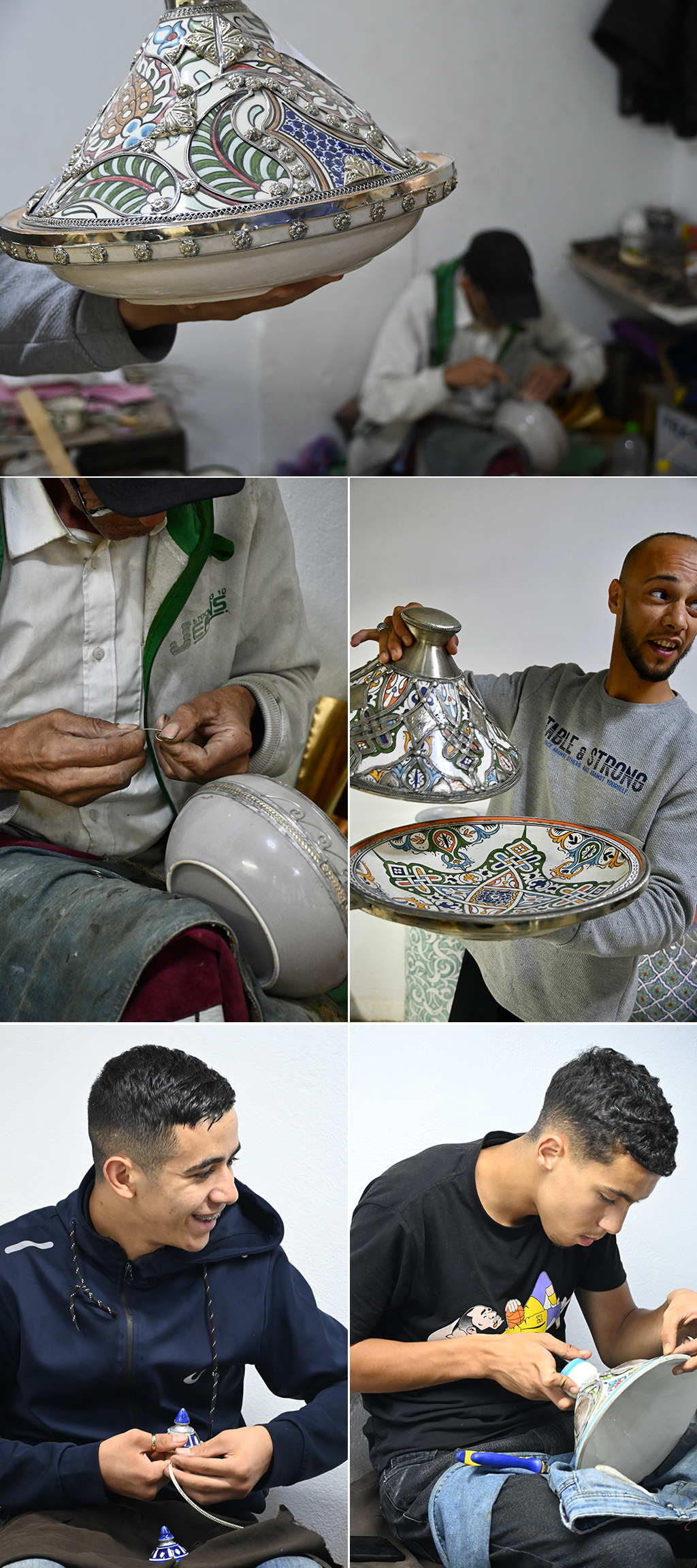
Outside the Medina, Atelier Art Naji is a ceramics studio. According to our guide at the atelier, all the ceramics (zellij) studios left the Medina long ago for more space outside the walls. Once inside the studios, we saw artisans throwing clay pots and tagines, painting them, and then, for some — post firing — adorning them with sterling (?) silver. They also have a program in which they work with local teens to teach them the fine art of Moroccan ceramics.
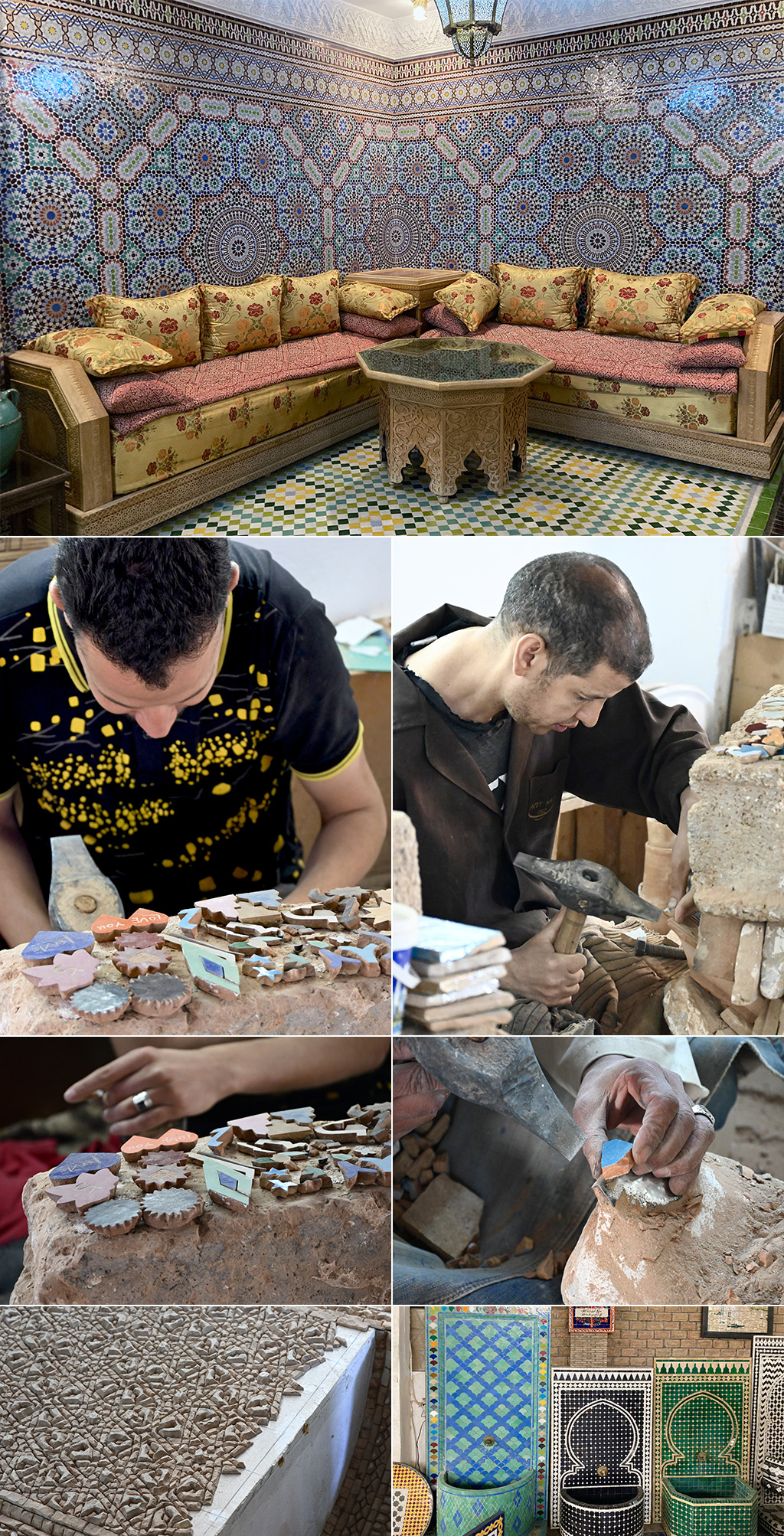
We were then shown the area where the zellij are made. Tiles of perhaps 6-inches square and 1/2-inch thick are skillfully chipped into all the shapes needed to create zellij patterns for walls, tables, and fountains. The tricky part is that the pieces of the patters are assembled with the colored sides facing down. The back of the tiles are all the same color and look like an organized pattern of mud lumps. The back is then coated with cement (weighty) or a resin (a new technology that weighs a lot less), and turned over for examination when any errors are revealed; a specialist chisels out mistakes and replaces them.
Fondouk el-Nejjarine
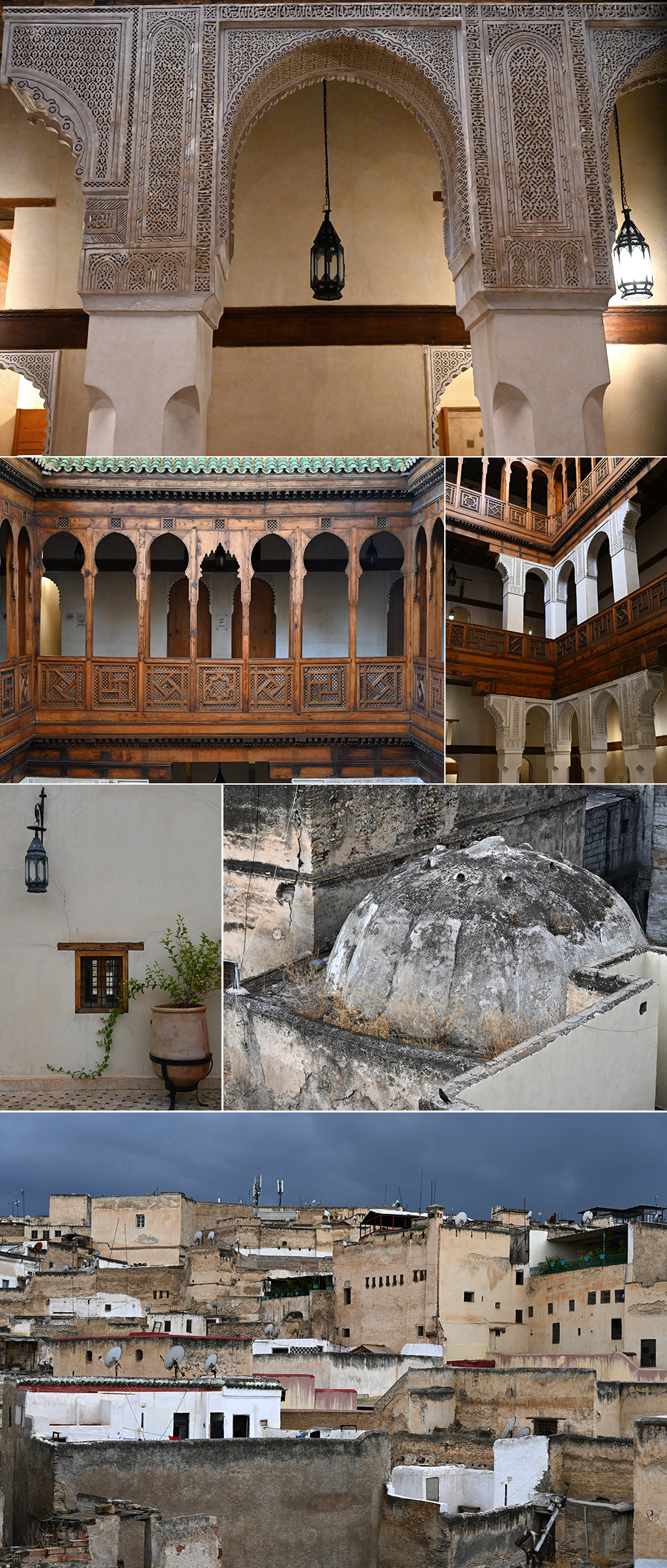
We visited the historic Fondouk el-Nejjarine (Funduq al-Najjarin); Nejjarine refers to the placement of this caravanserai in the heart of the carpenter’s souk. The building, originally an inn for caravan merchants, their pack animals, and trade goods, is now a museum dedicated to traditional woodworking arts and crafts, Le Musée Nejjarine des Arts et Métiers du Bois. Photos were not allowed in most of the facility, so what you see are some indoor shots and a few on/from the rooftop, where there is a café. The building dates to the early 18th century and features intricate plaster work and carved cedar wood. Because it is situated on a small plaza, it is one if the few buildings in Fès where the entire façade is visible.
Zaouia Moulay Idriss II/Al Qarawiyyin University

Said walked us through the streets until we came to the Zaouia Moulay Idriss II, a mausoleum and shrine of the founder of the city. We were permitted to look in from the doorway (not open to non-Muslim people), and we were told that this is the second most visited site in Morocco. The part of the Medina framed by this, the university, and the main mosque is considered a golden triangle or sacred zone in the city.
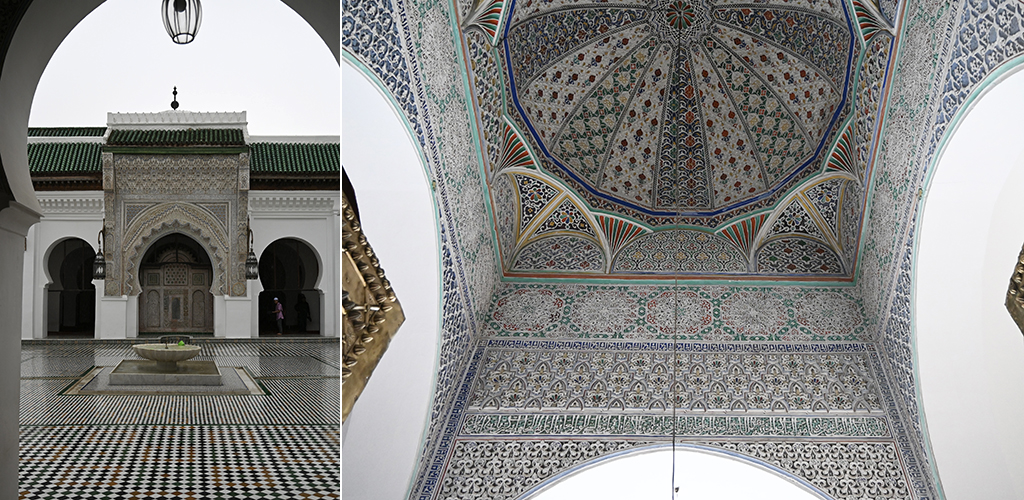
Just around the corner from the zaouia, we walked to the entrance of the University Al Qarawiyyin (Karaouine), the oldest continuously-operating university in the world, older than the universities of Bologna, Oxford, or the Sorbonne. Again, we were permitted to peek in through the doorway to see the stunning ceiling and glimpse the marble courtyard. It was founded by a wealthy woman named Fatima; her sister Maryan founded a mosque.
Medersa Al-Attarine

One afternoon, we took off as a group (bravely without a guide) to find the Medersa Al-Attarine. (Attarine refers to the spice and perfume market we walked through to get there.) Every time we stopped to consult the Moroccan GPS (a.k.a. a shop owner), we were told it’s just a couple of minutes straight ahead. First, “straight ahead” in Fès is to be taken with a grain of salt. Second, “a couple of minutes” may exist on a different time/space continuum… The madrasa was, indeed, at the bottom of this very long street (Rue Talaâ Kbira) and a couple of minutes may have been 10-15. It’s all downhill, which means returning is all uphill.
Built by the Marinids in 1323-1325 the madrasa served to train Islamic scholars, particularly in Islamic law and jurisprudence. As we saw in Marrakech, this was yet another architectural tour de force of zellij, carved plaster and cedar wood. No longer operating, its student dormitories were open for visitors to view and, if you walk up the narrow staircase to the third floor, you get a spectacular view of the rooftops of the University Al Qarawiyyin and the city of Fès. When marvelling at this madrasa, I realized that I never tire of seeing this kind of beauty. One cranky online comment said it looks like any other madrasa but, to me, that is like saying a rose looks like any other rose. Each madrasa has its own unique beauty.
Medersa Bou Inania
 After visiting the medersa, Markipedia – who was really geeking out to the magical aura of the Medina – and I let our group head back up the hill at their pace, and we meandered our way back slowly, checking out shops, talking to students, and popping in and out of any alley that held promise. As we neared the top of the hill and its puzzling Water Clock (non-functioning), we came upon another madrasa that had been closed earlier for prayer, but was now open. The Medersa Bou Inania fulfilled the same role as its neighboring madrasa with one exception; it was also (and seems to be to this day) a functioning mosque. It was named after the Marinid sultan who founded the school. Unlike any other we visited, we were able to see into the functioning prayer hall (empty at the time). My favorite visitor was curled up taking a mid-afternoon siesta.
After visiting the medersa, Markipedia – who was really geeking out to the magical aura of the Medina – and I let our group head back up the hill at their pace, and we meandered our way back slowly, checking out shops, talking to students, and popping in and out of any alley that held promise. As we neared the top of the hill and its puzzling Water Clock (non-functioning), we came upon another madrasa that had been closed earlier for prayer, but was now open. The Medersa Bou Inania fulfilled the same role as its neighboring madrasa with one exception; it was also (and seems to be to this day) a functioning mosque. It was named after the Marinid sultan who founded the school. Unlike any other we visited, we were able to see into the functioning prayer hall (empty at the time). My favorite visitor was curled up taking a mid-afternoon siesta.
Jardin Jnan Sbil
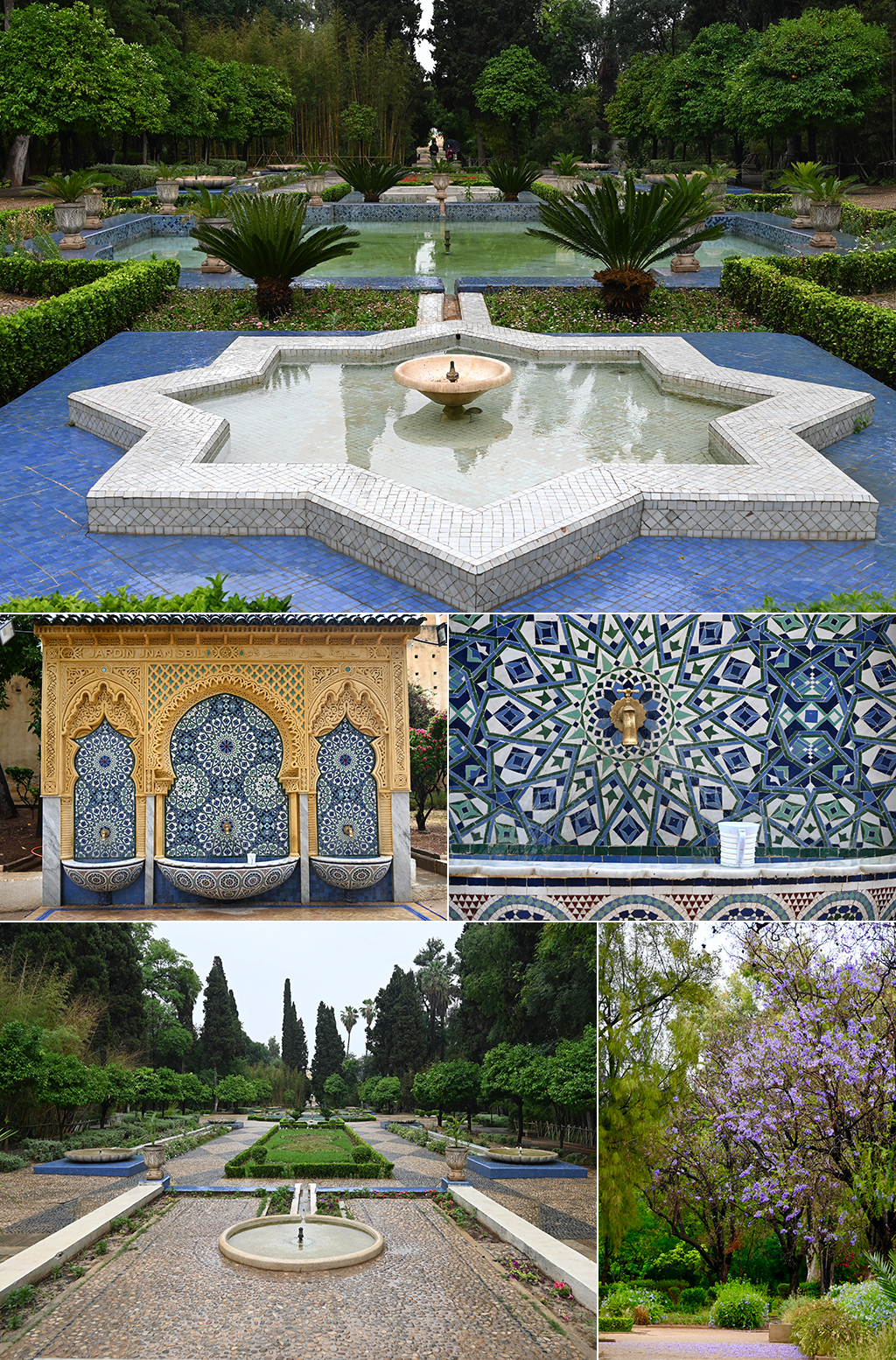
We will happily wander through any garden we find; our delightful Monsieur Ibrahim, from the riad, walked us to the garden one morning for a stroll in the drizzle. It was a charming garden, somewhat in need of TLC, but there was a romance in the air just the same. There were several formal spaces as well as more natural ones, and areas organized by genus or geography. At one end stood a beautiful zellij fountain and I notice there was a cup on the base. Then I started noticing cups perched on the edge of almost all fountains; I later learned that they are there for those who are thirsty and need a sip. Quite a lovely tradition.
The gardens were created in the late 19th century by the sultan, and were specifically to be used by royalty and guests; they were accessed from his palace by passages under the street. They were renovated and opened to the public in 2011 by King Mohammed VI.
La Cuisine
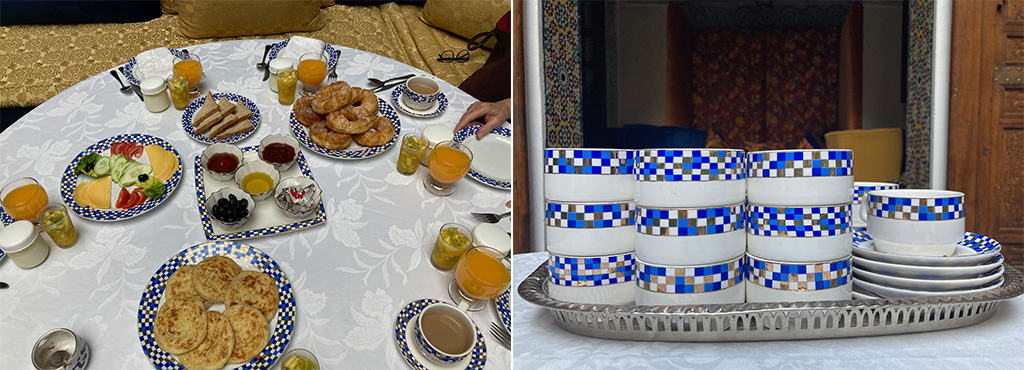
When arriving close to midnight, one doesn’t want a feast. Ibrahim, having been notified of our delayed arrival by our driver, Brahim, arranged for a light supper of soup and bread for our arrival. It was perfect. Meals can be ordered in advance to be served in the courtyard. Breakfasts are beautiful!
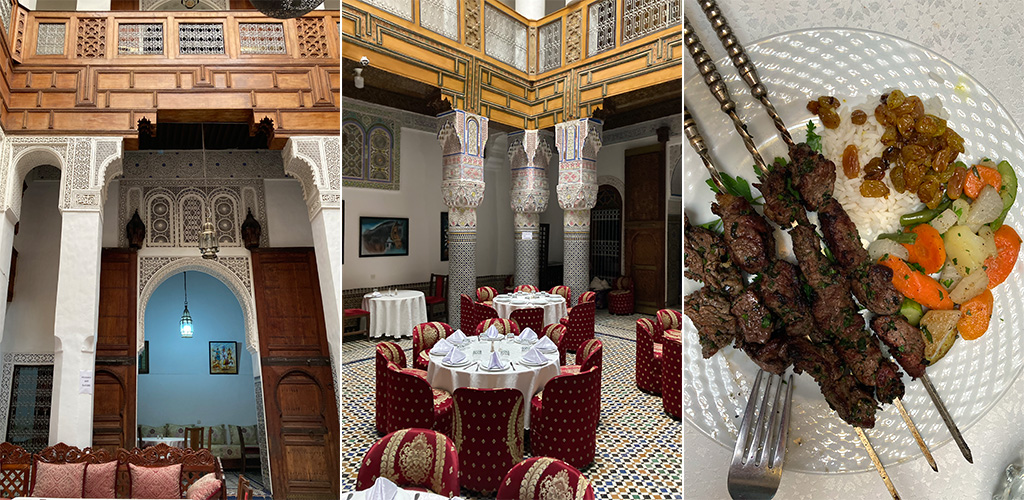
In the Medina, after a long-extended morning of touring, around 3:30pm, Said led us into a nearby restaurant in a riad: La Medina Bis Restaurant. They offer traditional fare that was excellent, with quick and pleasant service.
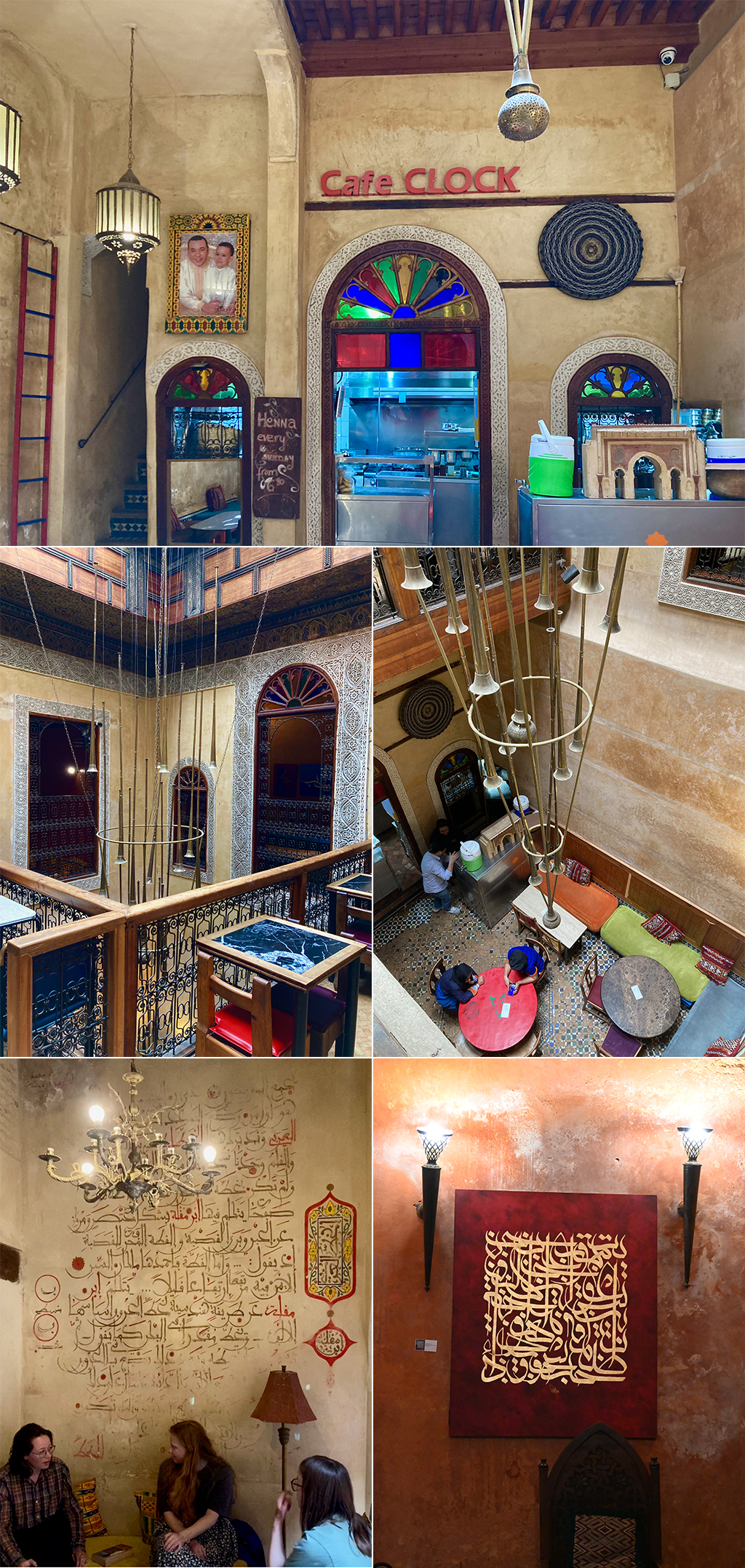
Another day, on the recommendation of one of our little group, Lisa, we ventured out on our own to lunch at Café Clock. This delightful café was founded in 2006 but British expat Mike Richardson who visited Fès and fell in love. (I get that…) The café serves traditional and non-traditional fare, and offers a lot of social/community events, as well — story telling, cooking classes, gallery exhibitions, and workshops. The contemporary art on display was stunning calligraphic pieces. Mark and I dined on amazing cheese briouats (phyllo pastry triangles) with a dipping sauce. Stay tuned for my recreation of the recipe.
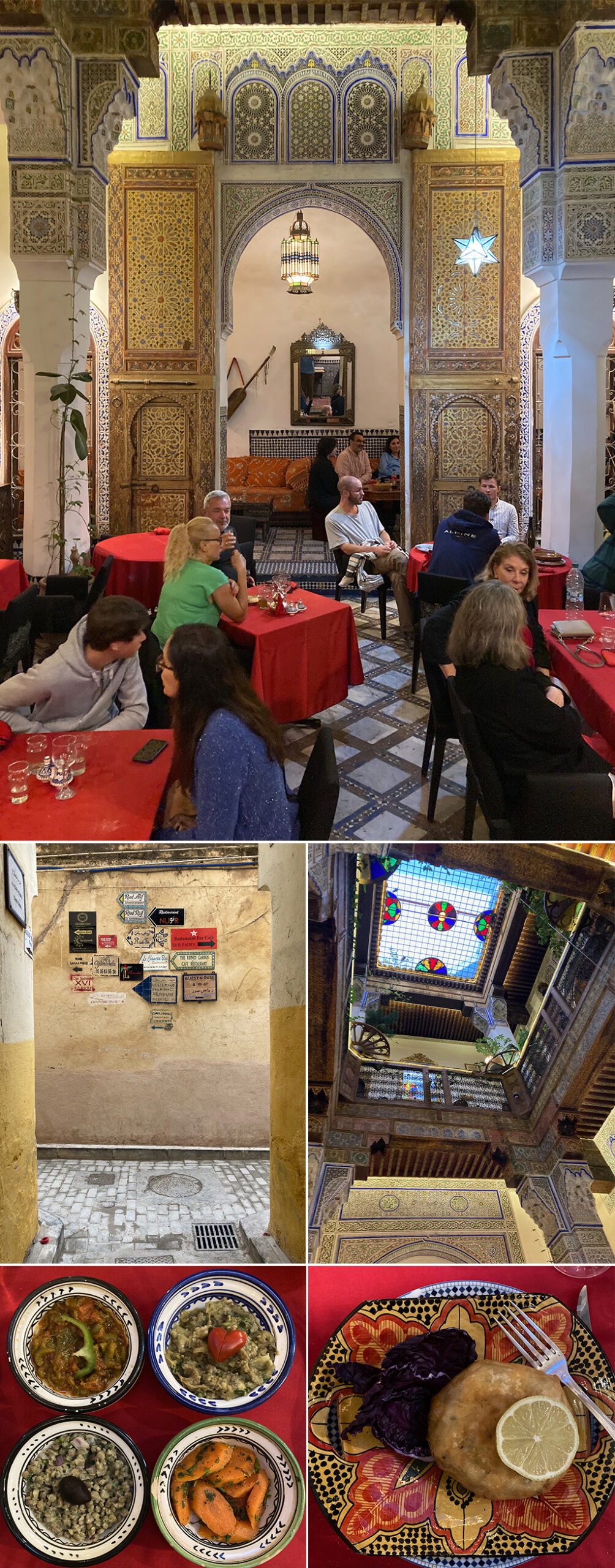
For our final dinner in Fès, we made reservations at a place recommended by foodie friends of Susan and Towny’s who had just been in Fès: Darori Resto. Though we thought we knew the way, based on a sign with an arrow we had seen earlier in the day, Ibrahim insisted that he call the restaurant and ask them to send a guide for us. I am so glad he did. Forty-five twists and turns later, the guide delivered us to the restaurant. Mohammad, our guide and one of the restaurant servers, later walked us back home. The food, as promised, was excellent. Mark and I each had a b’stilla (pastilla) — mine filled with seafood, his with chicken. Dessert was simple: cookies and mint tea. The sesame shortbread were incredible.
On to Chefchaouen!

Again, The tour for the six of us friends was set up and administered by Medina Travel — Mr. Kamal Oujaâ — kamalmedinatravel@gmail.com.
If you need a official, licensed guide in Fès, ours — Said Abali — was excellent. He offers tours in French and English. He can be reached at saidtours69@gmail.com.
Things to note (this will repeated with each post):
This site uses Akismet to reduce spam. Learn how your comment data is processed.
Developed and maintained by Inspiratech LLC.
Design by Themeshift.
Susan Aceto
July 12, 2023 at 5:02 amThese are remarkable. I hadn’t realized you were going again this year!
Best to you both,
Susan and Tom
Cocoa & Lavender
July 12, 2023 at 8:11 amThank you, Susan. We decided to visit Morocco close to our trip to Spain so that all the Mozarabic art and architecture might make more sense. Best to you both.
Ann Shoben
July 12, 2023 at 6:15 amHoly Smokes, David, what an incredible feast for the eyes! I’m bedazzled (is that a word?)
Cocoa & Lavender
July 12, 2023 at 8:12 amThanks, Ann! It was such an amazing trip and I am really enjoying reliving every moment by writing these posts. Morocco is, indeed, a feast for the eyes — at every turn.
Mimi Rippee
July 12, 2023 at 8:13 amSo beautiful. Such great colors. And the food!!!
Cocoa & Lavender
July 12, 2023 at 8:18 amYes, the food was amazing — oddly, those kebabs really blew my mind. So simple yet unforgettable. And the b’stilla? Amazing.
Mad Dog
July 12, 2023 at 1:04 pmStunning pictures once again!
I had a flatmate in Barcelona, back in 1991, who went to Fès during the Spanish August vacation period. Unlike you, he (Jim) got mugged, which is odd because he’s 6’1″ tall and was quite scruffy. He said his adversaries were three brothers with coresponding knives, relative to size and age and they both apologised and thanked him profusely. Apparently they got all his money in the world (with him in Morrocco), but fortunately Jim knew a Moroccan who’d lived in Barcelona. This man’s familly took him in, they were very poor, living in one room and kept him safe for several weeks, while his mother tried to wire him money from a Canadian bank. This proved to be very difficult, because North American banks (back then) didn’t trust the Moroccan banking system. Eventually Jim returned to Barcelona and moved by the adventure sent the Moroccan family his next month’s paycheck! Unperturbed, he went off to work in Bangkok as a writer and journalist in 1992.
Cocoa & Lavender
July 12, 2023 at 1:22 pmHaving been there both in 1991 and 2023, I have to see if there have been a lot of changes in Morocco. I remember being told to guard myself very carefully when I was there in 1991… pickpocketing and theft was rampant. The king (Mohammad VI) has really clamped down on graft in the medinas, and I felt so incredibly safe this time around. I’m sorry your friend had that experience in Fès, but I would definitely recommend anybody could go there now. But I love the part of the story where the family took care of him while he got things figured out. That is the warmth and generosity I have experienced in Morocco.
Raymund
July 12, 2023 at 6:39 pmWow, your journey through the Medina of Fès sounds absolutely captivating! The intricate maze of streets and alleys, bustling with people and filled with historical treasures, truly makes it a place that demands exploration with a knowledgeable guide. I can imagine the sense of awe you must have felt as you entered the exquisite Riad Myra, with its beautifully adorned courtyard and warm hospitality.
Cocoa & Lavender
July 12, 2023 at 9:00 pmIn one short paragraph, you were really able to sum up our experience! It was truly memorable, and I want to go back. And I will definitely stay in the Riad Myra again!
Eha
July 12, 2023 at 9:01 pmOh! and very much another OH! Late on the scene of all this fabulous beauty cannot wait to have the opportunity for a slow look . . . what beautiful riads! Thank you!!!
Cocoa & Lavender
July 15, 2023 at 6:24 amIt’s a truly beautiful city, and I can’t wait to go back!
Carolyne
July 12, 2023 at 9:46 pmAnother fabulous culture and culinary write-up. Thank you for sharing the beauty.
Cocoa & Lavender
July 15, 2023 at 6:24 amHappy to share, Carolyne! More coming next week.
sherry
July 13, 2023 at 1:24 amit’s all so stunning David. That tagine was so beautiful. I giggled at the taco place; it just seems so incongruous for some reason. And I laughed when i read – men dying… oh no, but it was dyeing fabric thank goodness 🙂 What a marvellous time you must have had of it. Everything is stunning and intricate, and the Medina is so dense. Incredible!
Cocoa & Lavender
July 15, 2023 at 6:25 amThanks for noticing that typo, Sherry! I may have to fire my proofreader. 🙂 The taco shop was a real surprise for me, as well. But I suppose it’s no different than any other ethnic food in any city. I wish I had gone inside and asked them to tell me the story of how it started. Maybe next time.
Karen (Back Road Journal)
July 15, 2023 at 8:55 amAnother fabulous adventure with the two of you to an incredible part of our world. I felt as though I was walking with you admiring each of those wonderful buildings.
Cocoa & Lavender
July 17, 2023 at 10:03 amThanks, Karen — I really love being able to share this with you.
Pauline
July 16, 2023 at 12:43 amIt all seems so magical David, and I can almost relate to it a little bit after visiting Granada, Spain and Turkey. The density of Medina is amazing, and full of so many artisan treasures. So wonderful you could explore so many of them. All of the food looked delicious, and travel always brings its complications doesn’t it? How wonderful they kept the restaurant open for you after your late arrival. I’ll be rereading your wonderful travel documentary. I doubt I will get to Morocco now, but never say never, but definitely with a guide. Thanks so much for all the time you put into this, it is travel magazine worthy. Superb photos.
Cocoa & Lavender
July 17, 2023 at 10:07 amIt is so important to be flexible when traveling, isn’t it Pauline? And sometimes, the glitches bring opportunities with them — like when the van breaks down and suddenly there are 9 locals including a mechanic there to help a group of strangers. And, yes, it was magical and it reminded us of Granada, Sevilla, and Córdoba, as well. We want to go again!
Frank | Memorie di Angelina
July 16, 2023 at 7:52 amAbsolutely stunning! It’s funny but some of the images remind me of the photographs and videos I’m seeing of Andalusia as we prepare for our trip in October. Actually, I guess it’s not surprising… I’m also impressed that you two ventured alone into that maze of alleyways!
Cocoa & Lavender
July 17, 2023 at 10:08 amThere are a lot of similarities, Frank — I know you will love Southern Spain.
Ben | Havocinthekitchen
July 17, 2023 at 4:28 pmWhile Morocco isn’t our top 10 countries on our travel bucket list, your trip sounds terrific – I may even rank it higher after your post 🙂 It seems like a beautiful country, and I’m fascinated with all those markets! Please keep sharing.
P.S. And our Croatian trip was two months ago, and I didn’t even go through the taken photos yet lol. Hopefully I can also share a post by autumn.
Cocoa & Lavender
July 21, 2023 at 2:49 pmI really look forward to your photos of Croatia, Ben. It’s definitely some place that we would like to go, and I know so little about it.
Morocco was not on Mark’s list at all, but I questioned to go, and he was so glad that I did! Thanks for reading these posts.
Christina Conte
July 23, 2023 at 9:40 pmYou were brave, I can imagine it’s probably like Venice on steroids as far as navigating your way! I had to laugh at the directions you were given: Italians always say, “sempre diritto” no matter where the location is! It’s just too funny! Loved your post, David, thanks for taking us along!
Cocoa & Lavender
August 17, 2023 at 12:14 pmIt reminded us a lot of getting lost in Venice… at least most everyone spoke French so I could ask directions!
Valentina
July 29, 2023 at 9:19 pmDavid, you really, really make me want to get on an airplane and go! Such stunning images — I want to be IN all of them. 🙂 ~Valentina
Cocoa & Lavender
August 17, 2023 at 12:14 pmPlease go, Valentina — you won’t regret it!